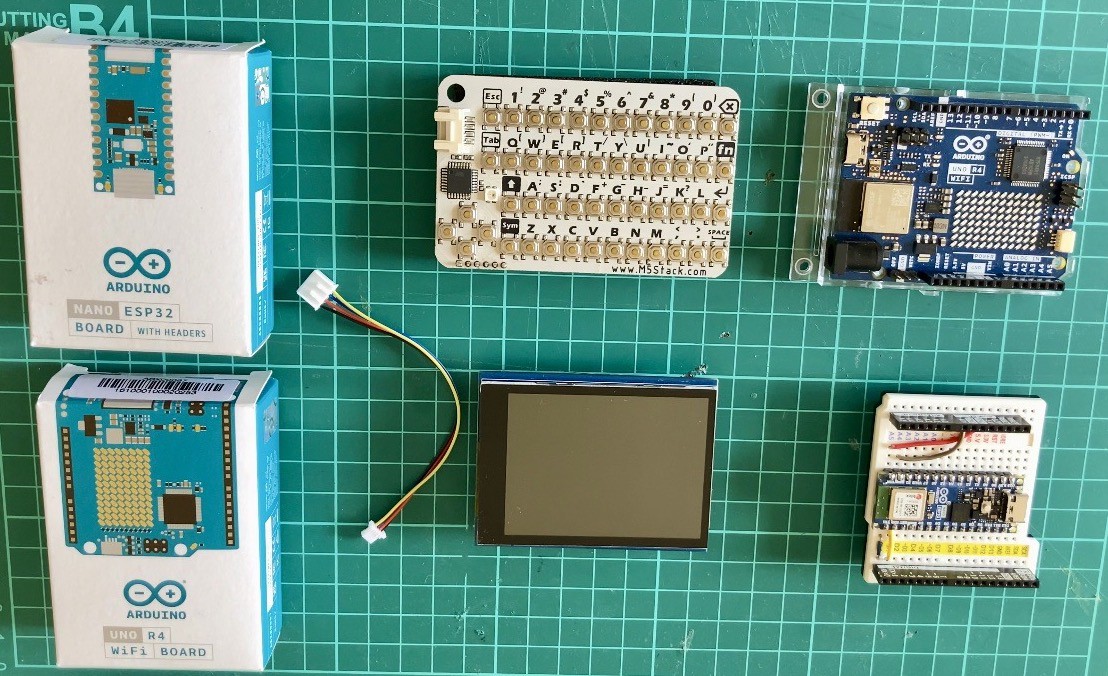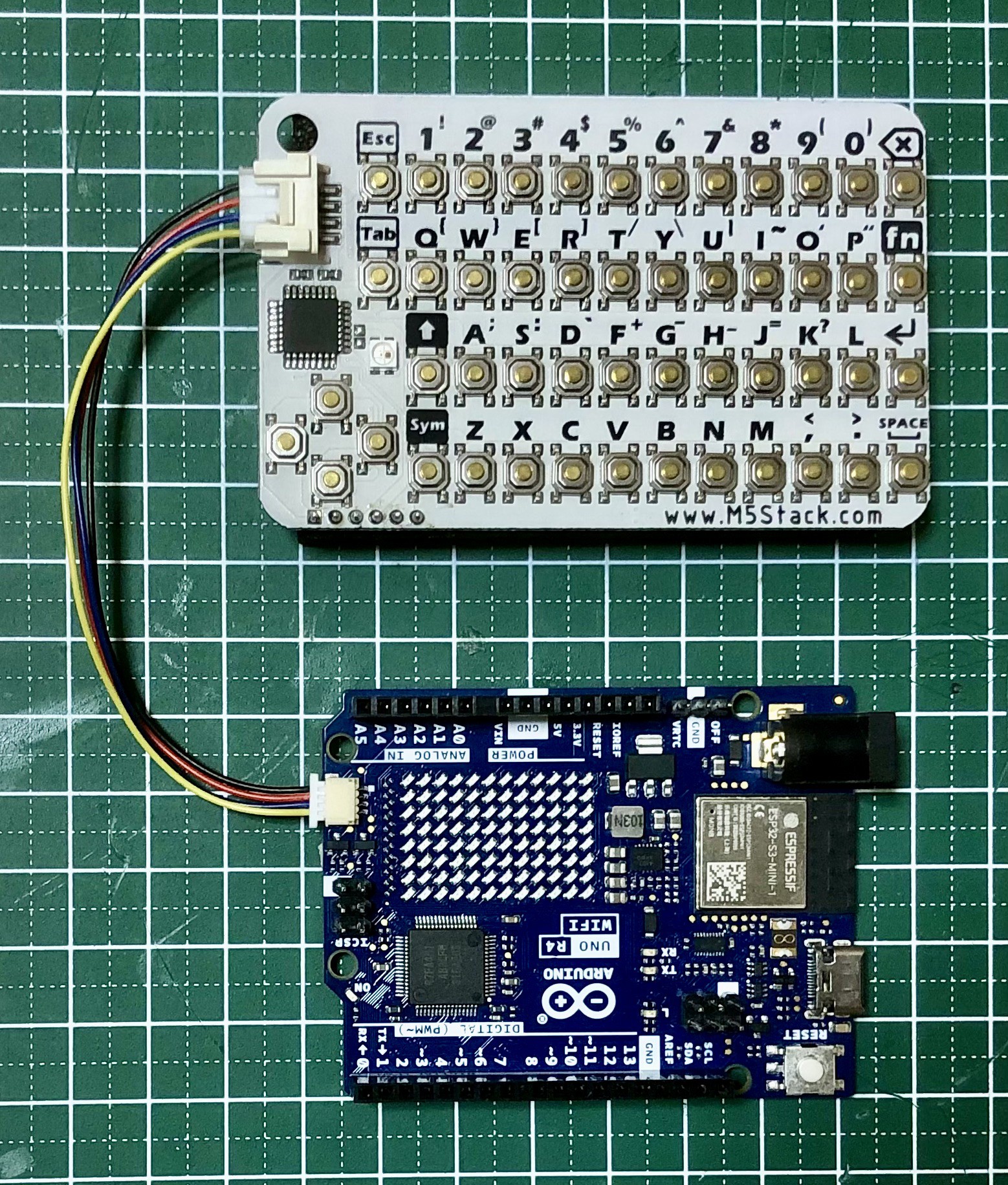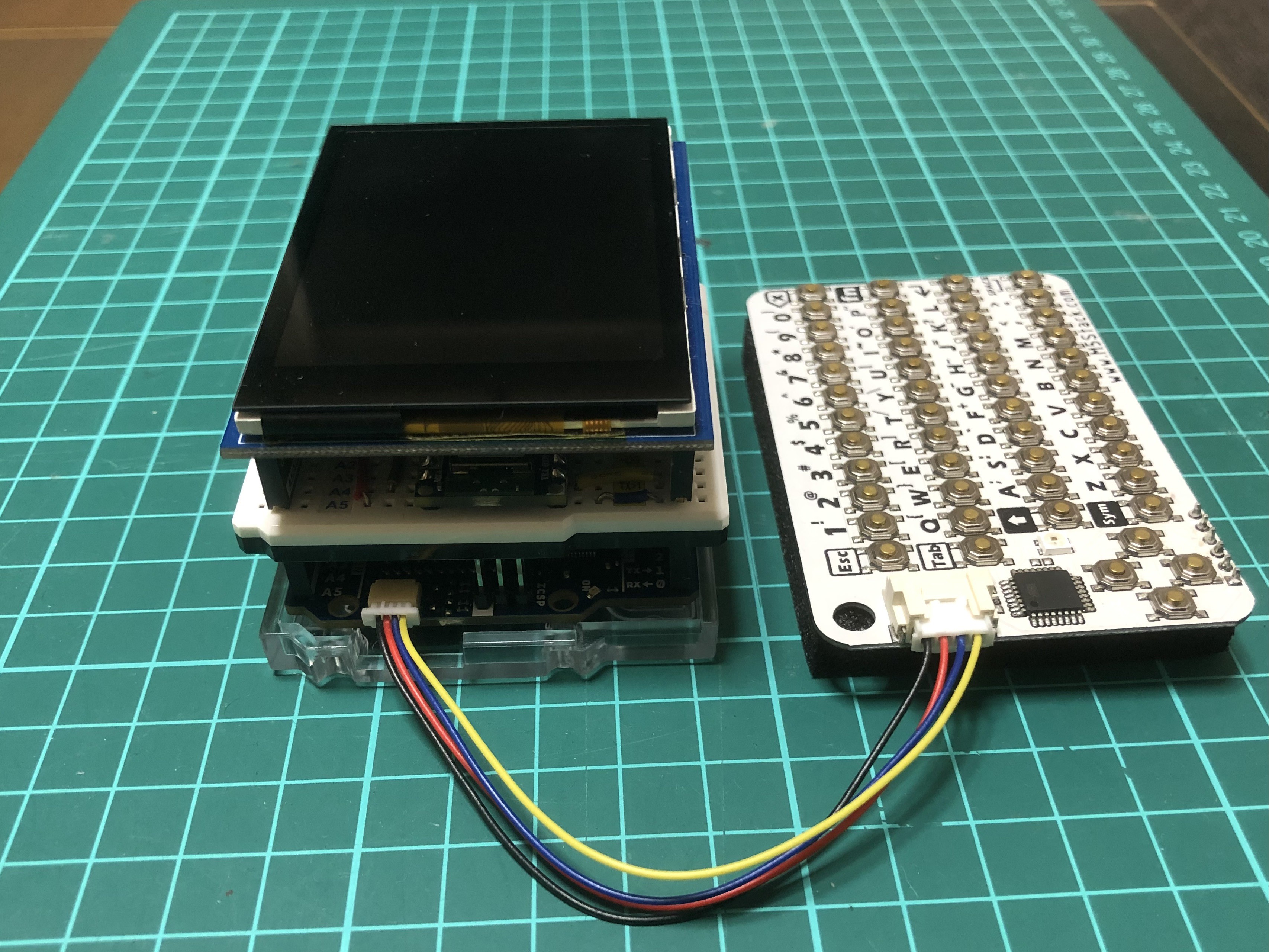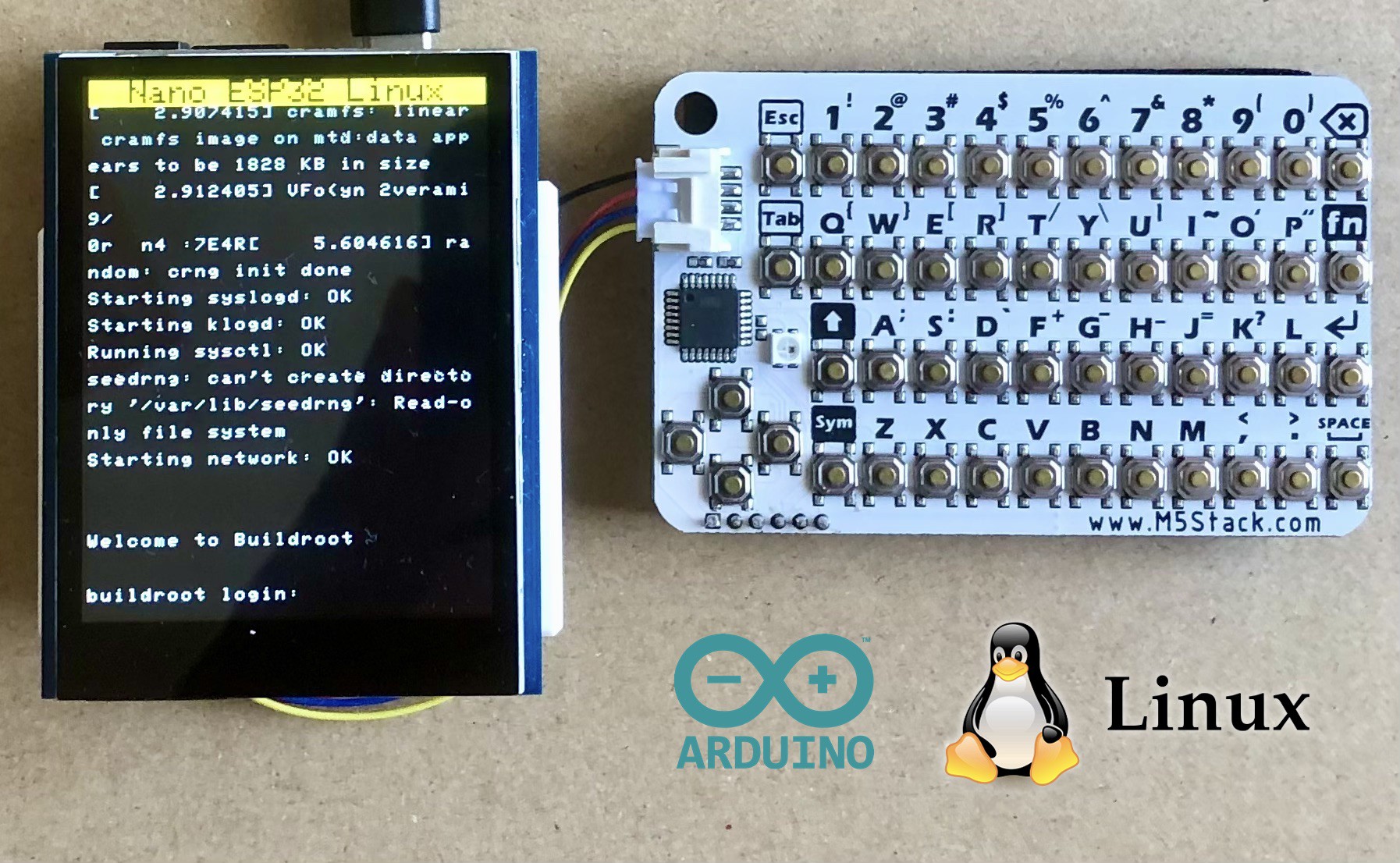-
1Build Linux and flash to the Arduino Nano ESP32
We would need another Linux machine (or a Linux VM) to cross-compile and build the kernels and filesystems. I am using a Ubuntu 22.04 Linux machine. Please execute the commands below to install prerequisites.
$ sudo apt install git wget flex bison gperf python3 python3-pip python3-venv $ sudo apt install cmake ninja-build ccache libffi-dev libssl-dev dfu-util libusb-1.0-0Download the script from here and execute it to build the Linux for the ESP32S3 target. This script automates compiling and flashing firmware and Linux to Arduino Nano ESP32.
$ bash rebuild-esp32s3-linux.shAfter flashing the board successfully and resetting or power cycling the board. we can see the boot-up console messages by connecting a USB-to-Serial adapter to the Nano ESP32's UART pins (TX0/RX0). But later in this project we will connect the Nano ESP32 to the UNO R4 WiFi via serial connection to emulate the command line terminal console.
-
2Setup hardware
In order to construct a computer, we require the hardware components depicted in the image.
![]()
We are using an ArduinoEZ ONE stackable breadboard shield to connect the Nano ESP32 to the UNO R4 Wi-Fi via a serial connection, as demonstrated in the image below.
![]()
The pins are connected as follows.
UNO R4 WiFi Nano ESP32
RX0 TX1
TX1 RX0
5V VIN
GND GNDWe are using an M5Stack CardKB, a tiny full QWERTY keyboard, connected to the Uno R4 WiFi via onboard Qwiic connector over I2C.
![]()
Once all the components have been assembled and stacked, the computer should look like the image below.
![]()
This design does not require soldering and is convenient to use.
-
3Build and Flash Uno R4 WiFi Firmware
The Arduino Uno R4 WiFi is used to drive an Adafruit TFT display and communicate to the Nano ESP32 over a serial connection. The complete sketch is given below.
#include <Wire.h> #include "SPI.h" #include "Adafruit_GFX.h" #include "Adafruit_ILI9341.h" #define CARDKB_I2C_ADDR 0x5F #define TEXT_WIDTH 8 #define TEXT_HEIGHT 16 // Height of text to be printed and scrolled #define BOTTOM_FIXED_AREA 0 // Number of lines in bottom fixed area (lines counted from bottom of screen) #define TOP_FIXED_AREA 16 // Number of lines in top fixed area (lines counted from top of screen) #define YMAX 320 // Bottom of screen area // Arduino Uno R3/R4 #define TFT_DC 9 #define TFT_CS 10 Adafruit_ILI9341 tft = Adafruit_ILI9341(TFT_CS, TFT_DC); // The initial y coordinate of the top of the scrolling area uint16_t yStart = TOP_FIXED_AREA; // yArea must be a integral multiple of TEXT_HEIGHT uint16_t yArea = YMAX - TOP_FIXED_AREA - BOTTOM_FIXED_AREA; // The initial y coordinate of the top of the bottom text line uint16_t yDraw = YMAX - BOTTOM_FIXED_AREA - TEXT_HEIGHT; // Keep track of the drawing x coordinate uint16_t xPos = 0; boolean escapeSeq = false; // We have to blank the top line each time the display is scrolled, but this takes up to 13 milliseconds // for a full width line, meanwhile the serial buffer may be filling... and overflowing // We can speed up scrolling of short text lines by just blanking the character we drew int blank[19]; // We keep all the strings pixel lengths to optimise the speed of the top line blanking void setup() { Serial.begin(115200); Serial1.begin(115200); Wire1.begin(); tft.begin(); tft.setRotation(0); // Must be 0 to work vertical scrolling correctly tft.fillScreen(ILI9341_BLACK); tft.setTextColor(ILI9341_BLACK, ILI9341_YELLOW); tft.fillRect(0, 0, 240, 16, ILI9341_YELLOW); tft.setTextSize(2); tft.print(" Nano ESP32 Linux"); tft.setTextColor(ILI9341_WHITE, ILI9341_BLACK); tft.setTextSize(1); tft.setScrollMargins(TOP_FIXED_AREA, BOTTOM_FIXED_AREA); for (byte i = 0; i < 18; i++) { blank[i] = 0; } } void loop(void) { while (Serial1.available()) { char c = Serial1.read(); // If it is a CR or we are near end of line then scroll one line if (c == '\r' || xPos > 231) { xPos = 0; yDraw = scroll_line(); // It can take 13ms to scroll and blank 16 pixel lines } // delete key if (c == 8) { xPos -= TEXT_WIDTH; Serial.print("\nDelete: "); //tft.drawChar(xPos, yDraw, 219, ILI9341_BLACK, ILI9341_BLACK , 1); tft.fillRect(xPos, yDraw, TEXT_WIDTH, TEXT_HEIGHT, ILI9341_BLACK); continue; } // start of ANSI Escape Sequence if (c == 27) { escapeSeq = true; } if (c > 31 && c < 128) { if (escapeSeq) { if ((c >= 'A' && c <= 'Z') || (c >= 'a' && c <= 'z')) { escapeSeq = false; } continue; } tft.drawChar(xPos, yDraw, c, ILI9341_WHITE, ILI9341_BLACK , 1); xPos += TEXT_WIDTH; blank[(18 + (yStart - TOP_FIXED_AREA) / TEXT_HEIGHT) % 19] = xPos; // Keep a record of line lengths } } while (Serial.available()) { char c = Serial.read(); Serial1.print(c); } Wire1.requestFrom(CARDKB_I2C_ADDR, 1); while (Wire1.available()) { byte b = Wire1.read(); switch (b) { case 0xA8: // Fn+C Serial1.write(0x03); // Send Ctrl-C break; case 0x96: // Fn+P Serial1.write(0x10); // Send Ctrl-P break; case 0x90: // Fn+R Serial1.write(0x12); // Send Ctrl-R break; default: break; } char c = b; if (c != 0) { Serial1.print(c); Serial.print(c, HEX); } } } int scroll_line() { int yTemp = yStart; // Store the old yStart, this is where we draw the next line // Use the record of line lengths to optimise the rectangle size we need to erase the top line tft.fillRect(0, yStart, blank[(yStart - TOP_FIXED_AREA) / TEXT_HEIGHT], TEXT_HEIGHT, ILI9341_BLACK); // Change the top of the scroll area yStart += TEXT_HEIGHT; // The value must wrap around as the screen memory is a circular buffer if (yStart >= YMAX - BOTTOM_FIXED_AREA) { yStart = TOP_FIXED_AREA + (yStart - YMAX + BOTTOM_FIXED_AREA); } // Now we can scroll the display tft.scrollTo(yStart); return yTemp; }We need to install the Adafruit_ILI9341 library through the Arduino IDE Library Manager. Then, we can upload the sketch to the Uno R4 WiFi board.
-
4Powering and booting up the Linux
We can power the Uno R4 WiFi through its USB-C connector, which in turn supplies power to the Nano ESP32 and LCD shield. Once powered, the Linux system boots up and displays the boot messages on the LCD.
![]()
-
5Live Demo
-
6Conclusion
In this project, we made a tiny Linux computer that is functional and opens up a way to create a plethora of embedded Linux applications using the Arduino ESP32 Nano and possibly many other MCUs-based boards in the future. This computer offers the flexibility of being powered by either batteries or a solar power system. There is another Linux port that supports WiFi, and during our testing, we successfully used wget and ping commands. This can be advantageous for IoT applications that use MQTT.
Ultra Low-powered Linux Computer using MCU
A portable computer that runs on a Linux operating system can fit in your pocket.





Discussions
Become a Hackaday.io Member
Create an account to leave a comment. Already have an account? Log In.